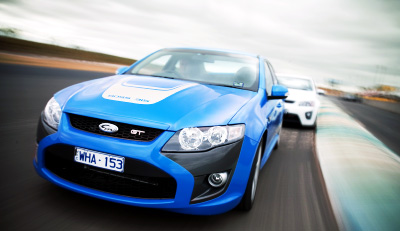The GT is, relatively, the least-inspiring car here. But in some respects it’s almost the GTS’s equal, and on offer at a 15 percent price discount.
To 100km/h and over the standing 400m, the GT is half a second slower than both the F6 and the GTS. However, in overtaking, although it’s slaughtered by the F6 from 80-120km/h and 120-160km/h, it line-balls the GTS from 80-120, and beats it by about 0.1 sec from 120-160.Lap times see the GT about 0.1 seconds in front of the F6, but in an actual race against the GT, the result would be 100 percent down to racecraft, as the GT has an edge in places where the F6 does not, and vice-versa. The driver better at exploiting the other’s weaknesses would win. This might not be the case in a race between it and the GTS, however.Daylight – more than a full second of it – separates the GT’s 70.23 from the GTS 69.13-second lap time. The two cars manage to pull virtually identical peak cornering loads both left and right around the circuit – about 1.1G in both cases. Yet the GT is slower in both corners, both doglegs and the kink. It’s also slower down both straights (on the main straight by 7.5km/h and on the back straight by only 0.2km/h – and despite emerging onto the back straight from the kink almost 4km/h behind the eight-ball). The pair also recorded identical maximum longitudinal accelerations during their fastest laps – both 0.58G.The brakes on the GT are characteristically different to the brakes on the GTS. The GT tends to deliver a lot of braking early, while the GTS’s stop is more even. How much of this is down to the style of Richards versus Tander is unclear. Peak brake applications by the GT on both the main straight and the back straight (which we analysed but haven’t tabulated) are as much as 18 percent higher than the GTS’s, though the averages (0.53G for the GT versus 0.58G for the GTS on the main straight and 0.67, GT, and 0.63, GTS, on the back straight) are quite similar.The GT slices almost 141km/h from its 201.8km/h maximum speed on the main straight in the space of 240 metres. This process takes 7.5 seconds. The GTS reduces its 209.2 Vmax by 139km/h in about 260 metres, in just 7.1 seconds. At its best, at a speed of about 183km/h and with full brakes applied, the GT generates 936kW of braking power. The GTS’s peak was 895kW. (Note that although the two stops are very similar, the GT’s is slightly less severe – it involves losing about 2.65 million joules, about three percent less energy than the GTS lost.)Least inspiring? Perhaps. Uninspiring? Nope; it’s an elite club. In performance terms, does the GT represent good value compared with the GTS? That depends who you ask. There’s no such thing as bipartisan support in the Ford v Holden debate. Price $66,590 Engine V8 (900), dohc, 32v Capacity 5.408 litres Bore/stroke 90.2/105.8mm Compression 10.8:1 Power 315kW@6500rpm Torque 551Nm@4750rpm Transmission 6-speed manual Kerb weight 1855kg Power-to-weight 170kW/tonne Tyres Dunlop SP Sport Maxx, 245/35ZR19 (f&r)





